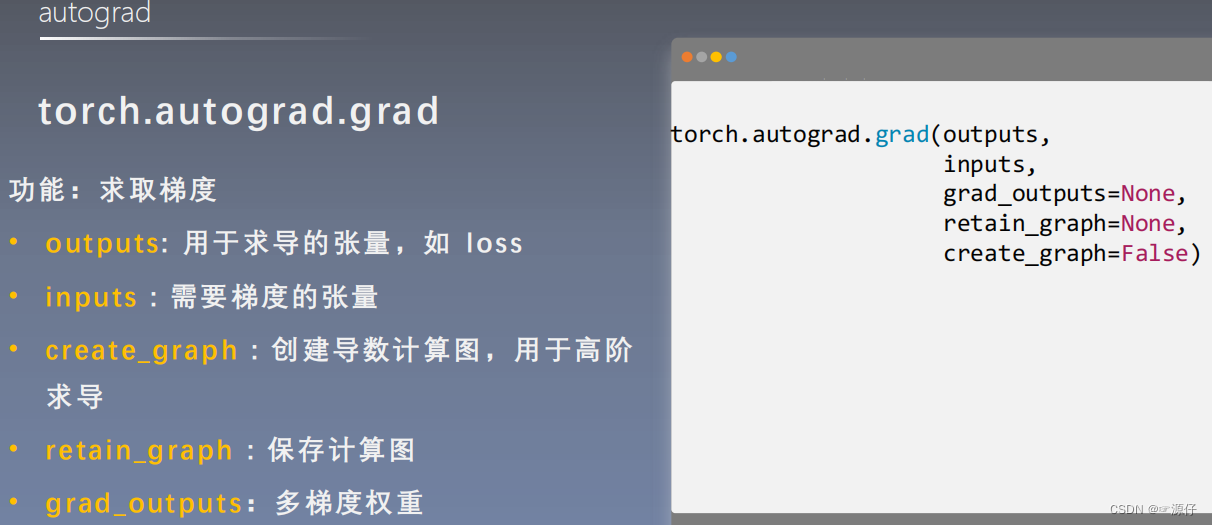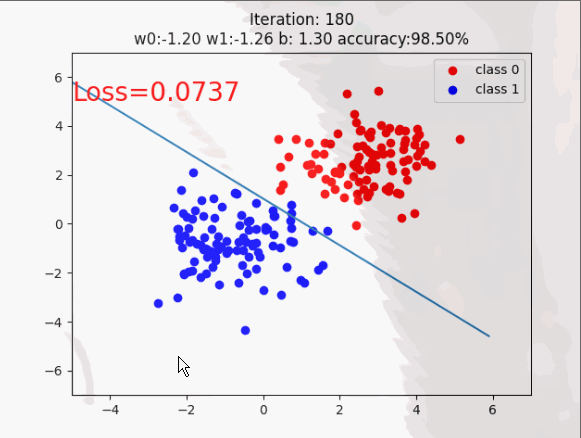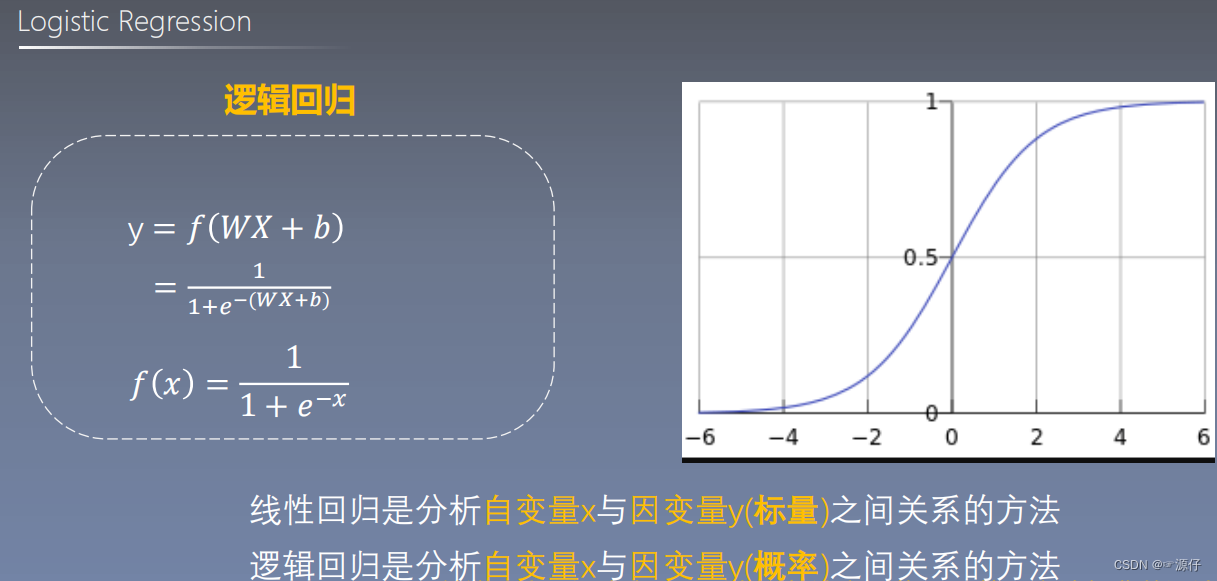Pytorch框架学习路径(五:autograd与逻辑回归)
文章目录
autograd
torch.autograd.backward方法求导

| 0、backward() |
代码如下:
import torch
torch.manual_seed(10)
# ====================================== retain_graph ==============================================
flag = True
# flag = False
if flag:
w = torch.tensor([1.], requires_grad=True)
x = torch.tensor([2.], requires_grad=True)
a = torch.add(w, x)
b = torch.add(w, 1)
y = torch.mul(a, b)
y.backward() # 反向传播
print(w.grad)
# y.backward()
OUT:
tensor([5.])
那我们执行两次反向传播呢?
import torch
torch.manual_seed(10)
# ====================================== retain_graph ==============================================
flag = True
# flag = False
if flag:
w = torch.tensor([1.], requires_grad=True)
x = torch.tensor([2.], requires_grad=True)
a = torch.add(w, x)
b = torch.add(w, 1)
y = torch.mul(a, b)
y.backward() # 反向传播
print(w.grad)
y.backward()
OUT:
![tensor([5.])](https://img-blog.csdnimg.cn/56063d706eee4a91a98a8160de085971.png)
- 你看,报错了,说尝试用计算机计算第二次反向传播,但是保存的计算图已经被释放。
- 解决办法:在第一次计算反向传播时,加入retain_graph=True ,具体代码如下:
# ====================================== retain_graph ==============================================
flag = True
# flag = False
if flag:
w = torch.tensor([1.], requires_grad=True)
x = torch.tensor([2.], requires_grad=True)
a = torch.add(w, x)
b = torch.add(w, 1)
y = torch.mul(a, b)
y.backward(retain_graph=True) # retain_graph=True
print(w.grad)
y.backward()
OUT:

| 1、torch.autograd.backward |
到现在我们都在说
backward,但是我们不是要说torch.autograd.backward吗?其实backward就是torch.autograd.backward,下面我们查看一下backward的源码。
def backward(self, gradient=None, retain_graph=None, create_graph=False, inputs=None):
r"""Computes the gradient of current tensor w.r.t. graph leaves.
The graph is differentiated using the chain rule. If the tensor is
non-scalar (i.e. its data has more than one element) and requires
gradient, the function additionally requires specifying ``gradient``.
It should be a tensor of matching type and location, that contains
the gradient of the differentiated function w.r.t. ``self``.
This function accumulates gradients in the leaves - you might need to zero
``.grad`` attributes or set them to ``None`` before calling it.
See :ref:`Default gradient layouts<default-grad-layouts>`
for details on the memory layout of accumulated gradients.
.. note::
If you run any forward ops, create ``gradient``, and/or call ``backward``
in a user-specified CUDA stream context, see
:ref:`Stream semantics of backward passes<bwd-cuda-stream-semantics>`.
Args:
gradient (Tensor or None): Gradient w.r.t. the
tensor. If it is a tensor, it will be automatically converted
to a Tensor that does not require grad unless ``create_graph`` is True.
None values can be specified for scalar Tensors or ones that
don't require grad. If a None value would be acceptable then
this argument is optional.
retain_graph (bool, optional): If ``False``, the graph used to compute
the grads will be freed. Note that in nearly all cases setting
this option to True is not needed and often can be worked around
in a much more efficient way. Defaults to the value of
``create_graph``.
create_graph (bool, optional): If ``True``, graph of the derivative will
be constructed, allowing to compute higher order derivative
products. Defaults to ``False``.
inputs (sequence of Tensor): Inputs w.r.t. which the gradient will be
accumulated into ``.grad``. All other Tensors will be ignored. If not
provided, the gradient is accumulated into all the leaf Tensors that were
used to compute the attr::tensors. All the provided inputs must be leaf
Tensors.
"""
if has_torch_function_unary(self):
return handle_torch_function(
Tensor.backward,
(self,),
self,
gradient=gradient,
retain_graph=retain_graph,
create_graph=create_graph,
inputs=inputs)
torch.autograd.backward(self, gradient, retain_graph, create_graph, inputs=inputs)
| 2、grad_tensors:多梯度权重 |
# ====================================== grad_tensors ==============================================
flag = True
# flag = False
if flag:
w = torch.tensor([1.], requires_grad=True)
x = torch.tensor([2.], requires_grad=True)
a = torch.add(w, x) # retain_grad()
b = torch.add(w, 1)
y0 = torch.mul(a, b) # y0 = (x+w) * (w+1)
y1 = torch.add(a, b) # y1 = (x+w) + (w+1) dy1/dw = 2
loss = torch.cat([y0, y1], dim=0) # [y0, y1]
print("Loss = {}".format(loss))
grad_tensors = torch.tensor([1., 2.])
# gradient=grad_tensors:多个梯度之间权重的设置。
loss.backward(gradient=grad_tensors) # gradient 传入 torch.autograd.backward()中的grad_tensors
print("w.grad = {}".format(w.grad))
OUT:
Loss = tensor([6., 5.], grad_fn=<CatBackward>)
w.grad = tensor([9.])
大家可能这里有点懵,9是怎么来的?
- 如果
loss用公式表示:
l o s s = [ ( x + w ) × ( w + 1 ) , ( x + w ) + ( w + 1 ) ] loss = [(x+w)\times(w+1) , (x+w)+(w+1)] loss=[(x+w)×(w+1),(x+w)+(w+1)],如果带入 x = 2 x = 2 x=2以及 w = 1 w=1 w=1,可以得到 l o s s = t e n s o r ( [ 6. , 5. ] loss = tensor([6., 5.] loss=tensor([6.,5.]loss的梯度计算:(下面我们就可以理解gradient=grad_tensors:多个梯度之间权重的设置)
∂ ( l o s s ) ∂ ( w ) = [ ( w + 1 ) + ( x + w ) , 2 ] \frac{\partial(loss)}{\partial(w)}=[(w+1)+(x+w) , 2] ∂(w)∂(loss)=[(w+1)+(x+w),2],
{ ∣ ( w + 1 ) + ( x + w ) 2 ∣ × ∣ 1 2 ∣ } w = 1 , x = 2 = 9 \begin{Bmatrix} \begin{vmatrix} (w+1)+(x+w) & 2 \\ \end{vmatrix} \times \begin{vmatrix} 1\\ 2 \\ \end{vmatrix} \end{Bmatrix}_{w=1,x=2}= 9 { ∣∣(w+1)+(x+w)2∣∣×∣∣∣∣12∣∣∣∣}w=1,x=2=9
torch.autograd.grad方法求导

# ====================================== autograd.gard ==============================================
flag = True
# flag = False
if flag:
x = torch.tensor([3.], requires_grad=True)
y = torch.pow(x, 2) # y = x**2
grad_1 = torch.autograd.grad(y, x, create_graph=True) # grad_1 = dy/dx = 2x = 2 * 3 = 6
print("一次求导结果: {}".format(grad_1))
grad_2 = torch.autograd.grad(grad_1[0], x) # grad_2 = d(dy/dx)/dx = d(2x)/dx = 2
print("二次求导结果: {}".format(grad_2))
OUT:
一次求导结果: (tensor([6.], grad_fn=<MulBackward0>),)
二次求导结果: (tensor([2.]),)
autograd小贴士(重点)
1. 梯度不自动清零
# ====================================== tips: 1 ==============================================
flag = True
# flag = False
if flag:
w = torch.tensor([1.], requires_grad=True)
x = torch.tensor([2.], requires_grad=True)
for i in range(4):
a = torch.add(w, x)
b = torch.add(w, 1)
y = torch.mul(a, b)
y.backward()
print(w.grad)
# w.grad.zero_()
OUT:
tensor([5.])
tensor([10.])
tensor([15.])
tensor([20.])
通过以上结果,我们可知,pytorch求梯度后,梯度不会自动清0的,是累加计算的.所以得不到我们正确的梯度结果.所以我们要对其进行手动清0 .添加grad.zero_()即可对梯度进行清0.
# ====================================== tips: 1 ==============================================
flag = True
# flag = False
if flag:
w = torch.tensor([1.], requires_grad=True)
x = torch.tensor([2.], requires_grad=True)
for i in range(4):
a = torch.add(w, x)
b = torch.add(w, 1)
y = torch.mul(a, b)
y.backward()
print(w.grad)
# _符号指的是inplace操作.
w.grad.zero_()
OUT:
tensor([5.])
tensor([5.])
tensor([5.])
tensor([5.])
依赖于叶子结点的结点(requires_grad默认为True)
先看一个案例:(在反向传播之前对 w w w进行加1)
flag = True
# flag = False
if flag:
w = torch.tensor([1.], requires_grad=True)
x = torch.tensor([2.], requires_grad=True)
a = torch.add(w, x)
b = torch.add(w, 1)
y = torch.mul(a, b)
w.add_(1)
"""
autograd小贴士:
梯度不自动清零
依赖于叶子结点的结点,requires_grad默认为True
叶子结点不可执行in-place
"""
y.backward()

报错说:需要求导的叶变量执行了in-place操作。
什么叫in-place操作?看下面一段代码就能懂了.
# ====================================== tips: 3 ==============================================
flag = True
# flag = False
if flag:
a = torch.ones((1, ))
print("a 的地址 : {}".format(id(a), a))
# a = a + b这种形式会改变储存地址
a = a + torch.ones((1, ))
print("a + torch.ones((1, ))后的地址 : {} a = {}".format(id(a), a))
# a += b这种形式会不改变储存地址
a += torch.ones((1, ))
print("a += torch.ones((1, ))后的地址: {} a = {}".format(id(a), a))
OUT:
a 的地址 : 2168491070160
a + torch.ones((1, ))后的地址 : 2168584372088 a = tensor([2.])
a += torch.ones((1, ))后的地址: 2168584372088 a = tensor([3.])
那这种in-place操作(又叫原位操作)为啥在pytorch中要避免使用呢!
举个例子 : 我们在旅游途中把旅游物品放在一个
10号行礼箱中,但中途有人把你行李箱中的物品换了,当你再用10号牌子取10号箱子的物品,这时候取到的东西还一样吗.计算图中也是,我们在反向传播过程中,要用到初始w的值,也就是用原来地址取获取,如果采用了in-place操作,地址是没变,但这个地址对应的值已经不是原来w的值了.
逻辑回归

其实
$WX + b$也是可以作为二分类的,当$WX + b > 0$时,类似$Sigmiod > 0.5$,当$WX + b < 0$时,类似$0 < Sigmiod < 0.5$但是Sigmiod是基于概率为1的分布的,是神经元的非线性作用函数(非线性),分类效果要优于线性分类。
由上图可知,对数几率回归就等于逻辑回归,二者之间可通过转换得到。
| 线性二分类代码案例如下 |
线性二分类代码案例如下:
import torch
import torch.nn as nn
import matplotlib.pyplot as plt
import numpy as np
torch.manual_seed(10)
# ============================ step 1/5 生成数据 ============================
sample_nums = 100
mean_value = 1.7
bias = 1
n_data = torch.ones(sample_nums, 2)
# 生成均值为1.7,标准差为1的正态分布
x0 = torch.normal(mean_value * n_data, 1) + bias # 类别0 数据 shape=(100, 2)
y0 = torch.zeros(sample_nums) # 类别0 标签 shape=(100)
x1 = torch.normal(-mean_value * n_data, 1) + bias # 类别1 数据 shape=(100, 2)
y1 = torch.ones(sample_nums) # 类别1 标签 shape=(100)
train_x = torch.cat((x0, x1), 0)
train_y = torch.cat((y0, y1), 0)
# ============================ step 2/5 选择模型 ============================
class LR(nn.Module):
def __init__(self):
super(LR, self).__init__()
self.features = nn.Linear(2, 1)
self.sigmoid = nn.Sigmoid()
def forward(self, x):
x = self.features(x)
x = self.sigmoid(x)
return x
lr_net = LR() # 实例化逻辑回归模型
# ============================ step 3/5 选择损失函数 ============================
loss_fn = nn.BCELoss()
# ============================ step 4/5 选择优化器 ============================
lr = 0.01 # 学习率
optimizer = torch.optim.SGD(lr_net.parameters(), lr=lr, momentum=0.9)
# ============================ step 5/5 模型训练 ============================
for iteration in range(1000):
# 前向传播
y_pred = lr_net(train_x)
# 计算 loss
loss = loss_fn(y_pred.squeeze(), train_y)
# 反向传播
loss.backward()
# 更新参数
optimizer.step()
# 清空梯度
optimizer.zero_grad()
# 绘图
if iteration % 20 == 0:
mask = y_pred.ge(0.5).float().squeeze() # 以0.5为阈值进行分类
correct = (mask == train_y).sum() # 计算正确预测的样本个数
acc = correct.item() / train_y.size(0) # 计算分类准确率
plt.scatter(x0.data.numpy()[:, 0], x0.data.numpy()[:, 1], c='r', label='class 0')
plt.scatter(x1.data.numpy()[:, 0], x1.data.numpy()[:, 1], c='b', label='class 1')
w0, w1 = lr_net.features.weight[0]
w0, w1 = float(w0.item()), float(w1.item())
plot_b = float(lr_net.features.bias[0].item())
plot_x = np.arange(-6, 6, 0.1)
plot_y = (-w0 * plot_x - plot_b) / w1
plt.xlim(-5, 7)
plt.ylim(-7, 7)
plt.plot(plot_x, plot_y)
plt.text(-5, 5, 'Loss=%.4f' % loss.data.numpy(), fontdict={
'size': 20, 'color': 'red'})
plt.title("Iteration: {}\nw0:{:.2f} w1:{:.2f} b: {:.2f} accuracy:{:.2%}".format(iteration, w0, w1, plot_b, acc))
plt.legend()
plt.show()
plt.pause(0.5)
if acc > 0.99:
break
这时初学者可能对自定义的数据有些模糊,啥样的呢!如下图所示,这就不迷糊了(通透)。

训练过程展示:
| 机器学习的五大步骤 |

以上代码也遵循了这个机器学习的五大步骤哈。

